The Coast Reporter minions only publish on a Friday so it hits the boxes April 25, six days before the month of record actually begins. My favorite months are those that begin on Friday; that only happens in August this year but my special favorite was in April 2022, when I described viewing the Apollo 11 landing site with binoculars. My next similar chance will be 2033, when I may or may not have lost interest.
For this article I’ll use that long lead time to suggest people hit the beach to see some remarkable tides. New Moon and its closest perigee of the year happen before just noon on April 27 and the tide ranges peak April 28 to 30. I’m still not sure why the two-day delay but you can see the details for the Pt. Atkinson station at: tide-forecast.com/locations/Point-Atkinson-British-Columbia-2/tides/latest
The Eta Aquariid meteors are due to peak on May 5. This group averages about 60 per hour and should spread over about five days. The radiant is due east and rises about 03:00 each morning, so there will be a limited viewing window daily before dawn.
Venus and Saturn are now in the morning sky after March’s evening displays. Because the ecliptic is pretty low to the west of the Sun for us in the Northern Hemisphere, we’ll see them both low in the east as they pull away from the Sun. For the first week of May, Saturn will be just to the right of brilliant Venus and will pull away from it up and west until April 22 when it will be just below and left of a waning crescent Moon. For those watching the pair on April 30 you should see the International Space Station setting in the east just left of Venus about 04:55. The ISS passes have been morning ones through April but switch to evening ones by mid-May, as many as three per day on either side of midnight. Check heavens-above.com, plug in your lat/long coordinates (easy on Google Earth) and you’re away to the races. One of my most favorite astro-sites.
Mars has been pretty impressive this year; it was at opposition in mid-January and its closest approach to Earth. We’ve since passed it and pulled away and it’s doing its normal thing –– prograde motion from west to east relative to the stars. It has left Gemini and is traversing Cancer into Leo in late May. From the Gemini pair of Castor and Pollux you can watch it move eastward every night until by May 31 it has moved to about eight degrees (one palm width) right of Regulus. That’s the brightest star in Leo and just about the same brightness as Mars, although it’s distinctly bluish-white and twinkly, not pinkish and steady like Mars. It’s the difference between looking at the glowing surface of a ball of fusing hydrogen at 12,000K versus a small rusty ball of rock at 200K.
For the astro-trivia buffs, there’s more to Regulus than you’d think: it’s not one star but four. There are two large stars that orbit each other (masses 4x and 0.8x our Sun) and each apparently has a smaller companion star. We see the big one, Regulus A, which is by far the brightest, a blue sub-giant with a surface temperature twice that of our Sun and rotating so quickly – 15.9 hours – that its equatorial diameter is 33 per cent bigger than its polar diameter. Picture a guy singing in Italian and tossing a spinning ball of pizza dough in the air, except that the “dough” at the edges is moving about 0.1 per cent the speed of light, almost fast enough to tear it apart from centrifugal force.
Jupiter has been bright and beautiful high in the sky but it’s sinking towards its superior conjunction on June 24 (opposite side of the Sun). It will be just below a thin New Moon after sunset on April 30 and again just left of the Moon after sunset May 27.
Yes, we’re still waiting for the predicted flareup of T Corona Borealis. Check its brightness goings-on and many other events at spaceweather.com/
The next SCAC monthly meeting will be at the Sechelt Library, May 9, at 7 p.m. The speaker will be Dr. Aaron Boley, UBC Associate Professor of Planetary Astronomy and co-director of The Outer Space Institute. His topic will be: “Planets, Debris, and Who Owns Space?”



